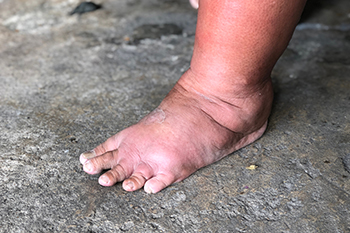Connect With Us
Blog
Items filtered by date: January 2023
Foot Stretches That May Help Plantar Fasciitis

Foot pain may be reduced when specific stretches and exercises are frequently performed. Plantar fasciitis is a common form of foot pain, and is felt on the sole of the foot. The affected foot may feel better when the foot is placed on the opposite knee while sitting in a chair. As the heel is held with one hand and the toes are grasped with the other, a gentle stretch can be felt along the bottom of the foot. This can be followed by kneeling on a pillow, and placing the hands on the floor, while slowly sitting back on the ankles. This is another plantar fascia stretch that can help this foot condition. Additionally, some people enjoy rolling the bottom of their foot on a can or water bottle, which can be effective in strengthening the foot. If you would like to learn about additional foot stretches to help plantar fasciitis, please consult with a podiatrist who can give you expert advice about this condition.
Foot Pain
Foot pain can be extremely painful and debilitating. If you have a foot pain, consult with Dr. Royall from Mountain View Foot & Ankle Clinic. Our doctor will assess your condition and provide you with quality foot and ankle treatment.
Causes
Foot pain is a very broad condition that could be caused by one or more ailments. The most common include:
- Bunions
- Hammertoes
- Plantar Fasciitis
- Bone Spurs
- Corns
- Tarsal Tunnel Syndrome
- Ingrown Toenails
- Arthritis (such as Gout, Rheumatoid, and Osteoarthritis)
- Flat Feet
- Injury (from stress fractures, broken toe, foot, ankle, Achilles tendon ruptures, and sprains)
- And more
Diagnosis
To figure out the cause of foot pain, podiatrists utilize several different methods. This can range from simple visual inspections and sensation tests to X-rays and MRI scans. Prior medical history, family medical history, and any recent physical traumatic events will all be taken into consideration for a proper diagnosis.
Treatment
Treatment depends upon the cause of the foot pain. Whether it is resting, staying off the foot, or having surgery; podiatrists have a number of treatment options available for foot pain.
If you have any questions, please feel free to contact our office located in Lehi, UT . We offer the newest diagnostic and treatment technologies for all your foot care needs.
Do Your Child's Feet Hurt?
A Common Reason for Stress Fractures

A hairline fracture that happens in the foot is known as a stress fracture. It can occur in one or more of the 26 bones in each foot and causes difficulty walking. A stress fracture happens gradually, and a common reason is from increasing speed and distance too quickly while running. After a proper diagnosis has been performed, which is generally done by having an MRI taken, treatment can begin. The foot has a better chance of making a complete recovery by keeping weight off of it, and crutches can be useful in accomplishing this. Many patients find it helpful to wrap the affected foot with an elastic bandage, which can help provide the necessary stability as the healing process occurs. If you have foot pain and think you may have a stress fracture, it is strongly urged that you are under the care of a podiatrist who can provide you with the correct medical treatment.
Stress fractures occur when there is a tiny crack within a bone. To learn more, contact Dr. Royall from Mountain View Foot & Ankle Clinic. Our doctor can provide the care you need to keep you pain free and on your feet.
How Are They Caused?
Stress fractures are the result of repetitive force being placed on the bone. Since the lower leg and feet often carry most of the body’s weight, stress fractures are likely to occur in these areas. If you rush into a new exercise, you are more likely to develop a stress fracture since you are starting too much, too soon. Pain resulting from stress fractures may go unnoticed at first, however it may start to worsen over time.
Risk Factors
- Gender – They are more commonly found in women compared to men.
- Foot Problems – People with unusual arches in their feet are more likely to develop stress fractures.
- Certain Sports – Dancers, gymnasts, tennis players, runners, and basketball players are more likely to develop stress fractures.
- Lack of Nutrients – A lack of vitamin D and calcium may weaken the bones and make you more prone to stress fractures
- Weak Bones – Osteoporosis can weaken the bones therefore resulting in stress fractures
Stress fractures do not always heal properly, so it is important that you seek help from a podiatrist if you suspect you may have one. Ignoring your stress fracture may cause it to worsen, and you may develop chronic pain as well as additional fractures.
If you have any questions, please feel free to contact our office located in Lehi, UT . We offer the newest diagnostic and treatment technologies for all your foot care needs.
Approximate Recovery Time for Bunion Surgery

A bunion is defined as a bony protrusion that is found on the side of the big toe, which may shift toward the other toes as it becomes larger. Corns may form on the side of the bunion from rubbing against the shoe, and this is often uncomfortable. Patients may choose to have bunion surgery, which is generally successful in removing the bunion, and straightening the big toe. A cast is often worn that can stabilize the foot, and existing pain and swelling will gradually diminish in approximately six weeks. Research has shown that adequate rest may accelerate healing, and many people choose to take time off from work. The foot may become stronger when specific exercises are performed, in addition to improving flexibility and range of motion. If you have a bunion and are considering surgery for permanent removal, please consult with a podiatrist who can determine if this is correct for you.
Foot surgery is sometimes necessary to treat a foot ailment. To learn more, contact Dr. Royall of Mountain View Foot & Ankle Clinic. Our doctor will assist you with all of your foot and ankle needs.
When Is Surgery Necessary?
Foot and ankle surgery is generally reserved for cases in which less invasive, conservative procedures have failed to alleviate the problem. Some of the cases in which surgery may be necessary include:
- Removing foot deformities like bunions and bone spurs
- Severe arthritis that has caused bone issues
- Cosmetic reconstruction
What Types of Surgery Are There?
The type of surgery you receive will depend on the nature of the problem you have. Some of the possible surgeries include:
- Bunionectomy for painful bunions
- Surgical fusion for realignment of bones
- Neuropathy decompression surgery to treat nerve damage
Benefits of Surgery
Although surgery is usually a last resort, it can provide more complete pain relief compared to non-surgical methods and may allow you to finally resume full activity.
Surgical techniques have also become increasingly sophisticated. Techniques like endoscopic surgery allow for smaller incisions and faster recovery times.
If you have any questions please feel free to contact our office located in Lehi, UT . We offer the newest diagnostic and treatment technologies for all your foot and ankle needs.
How to Properly Diagnose Sever’s Disease

Children who frequently participate in sporting activities may be prone to developing Sever’s disease. It is a condition that affects the growth plate in the heel in children and young teenagers, and limping is a noticeable sign. The foot grows to its full size during early puberty and often grows faster than the surrounding tendons and muscles. The foot can become less flexible and can cause extra pressure where the Achilles tendon connects to the heel. A diagnosis that is referred to as the squeeze test is often performed, which is done by squeezing both sides of the heel. Flexibility may be limited, and it may be painful to walk. Effective prevention methods can include having your child wear shoes that have additional cushioning in the heel area, and performing specific stretches that can strengthen the heel. If your active child has heel pain, please consult with a podiatrist who can accurately diagnose Sever’s disease, and offer correct treatment options.
Sever's disease often occurs in children and teens. If your child is experiencing foot or ankle pain, see Dr. Royall from Mountain View Foot & Ankle Clinic. Our doctor can treat your child’s foot and ankle needs.
Sever’s Disease
Sever’s disease is also known as calcaneal apophysitis, which is a medical condition that causes heel pain I none or both feet. The disease is known to affect children between the ages of 8 and 14.
Sever’s disease occurs when part of the child’s heel known as the growth plate (calcaneal epiphysis) is attached to the Achilles tendon. This area can suffer injury when the muscles and tendons of the growing foot do not keep pace with bone growth. Therefore, the constant pain which one experiences at the back of the heel will make the child unable to put any weight on the heel. The child is then forced to walk on their toes.
Symptoms
Acute pain – Pain associated with Sever’s disease is usually felt in the heel when the child engages in physical activity such as walking, jumping and or running.
Highly active – Children who are very active are among the most susceptible in experiencing Sever’s disease, because of the stress and tension placed on their feet.
If you have any questions, please feel free to contact our office located in Lehi, UT . We offer the newest diagnostic and treatment technologies for all your foot and ankle injuries.
Elevating Swollen Feet

Swelling of the feet is undoubtedly pesky and can make the feet feel puffy, uncomfortable, and inflated. Your feet may swell up for different reasons. For example, foot swelling can be attributed to pregnancy, poor circulation, dietary choices, and many other reasons. If an individual notices that their feet are swollen, they might consider slightly elevating the feet. A person might lie down on their back and elevate their feet and lower legs to a height that is above their heart. This is sometimes particularly easy to perform with a hospital bed because it enables the foot of the bed to rise, which is conducive to elevating the feet. The point of elevating the feet is essential to facilitate blood circulation and encourage blood with fresh oxygen to travel to these elevated limbs. If you struggle with swelling of the feet, you may want to seek out the help of a podiatrist who can help you manage this condition. Schedule an appointment today.
Swollen feet can be a sign of an underlying condition. If you have any concerns, contact Dr. Royall of Mountain View Foot & Ankle Clinic. Our doctor can provide the care you need to keep you pain-free and on your feet.
Swollen feet are a common ailment among pregnant women and people who stand or sit for extended periods. Aging may increase the possibility of swollen feet and patients who are obese often notice when their feet are swelling too. There may be medical reasons why swollen feet occur:
- Phlebitis - A condition that causes the veins to become inflamed and can also cause leg pain.
- Liver disease - This may lead to low blood levels of albumin which is a protein. This can cause fluid in the blood to pass into the tissues and several areas of the body can become swollen.
- Heart failure - When the heart doesn’t pump properly the blood that is normally pumped back to the heart can pool in the veins of the legs causing swollen feet.
- Kidney disease - One of the main functions of the kidneys is releasing excess fluid in the body. This type of condition can make it difficult for the kidneys to function properly, and as a result the feet may become swollen.
- Deep-vein thrombosis (DVT)- This is a serious condition where blood clots form in the veins of the legs. They can block the return of blood from the legs to the heart which may cause the feet to swell. It is important to be treated by a podiatrist if this condition is present.
Swollen feet can also be caused by bone and tendon conditions, including fractures, arthritis, and tendinitis. Additionally, there may be skin and toenail conditions and an infection may cause the feet to swell. Patients who take medicine to treat high blood pressure may be prone to getting swollen feet.
Many patients elevate their feet to help relieve the swelling and this is generally a temporary remedy. When a podiatrist is consulted the reason behind the swelling can be uncovered and subsequently treated.
If you have any questions please feel free to contact our office located in Lehi, UT . We offer the newest diagnostic tools and technology to treat your foot and ankle needs.
Blog Archives
- April 2025
- March 2025
- February 2025
- January 2025
- December 2024
- November 2024
- October 2024
- September 2024
- August 2024
- July 2024
- June 2024
- May 2024
- April 2024
- March 2024
- February 2024
- January 2024
- December 2023
- November 2023
- October 2023
- September 2023
- August 2023
- July 2023
- June 2023
- May 2023
- April 2023
- March 2023
- February 2023
- January 2023
- December 2022
- November 2022
- October 2022
- September 2022
- August 2022
- July 2022
- June 2022
- May 2022
- April 2022
- March 2022
- February 2022
- January 2022
- December 2021
- November 2021
- October 2021
- September 2021
- August 2021
- July 2021
- June 2021
- May 2021
- April 2021
- March 2021
- February 2021
- January 2021
- December 2020
- November 2020
- October 2020

